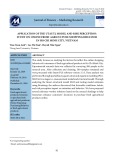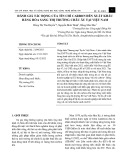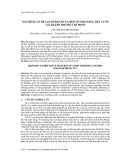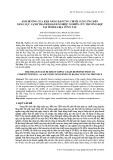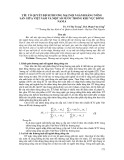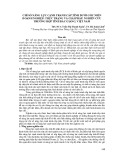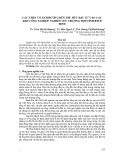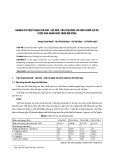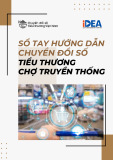
VNU Journal of Science: Economics and Business, Vol. 35, No. 5E (2019) 12-25
12
Original Article
Diversion Effect of Economic Integration Agreements
Nguyen Thi Hoang Oanh*, Duong Thi Thuy Linh
Thai Nguyen University of Technology, Tich Luong, Thai Nguyen City, Thai Nguyen, Vietnam
Received 05 November 2019
Revised 20 December 2019; Accepted 26 December 2019
Abstract: Signing Economic Integration Agreements has proliferated during last three decades. A
country signs more and more agreements. Owning the agreements not only generates trade
creation but also trade diversion. The diversion effect of Economic Integration Agreements (EIAs)
on the probability of products survival and export growth in a market is found in current paper.
Using the probit function for 149 countries in SITC 4-digit level from 1962 to 2000, we find the
hazard rate of product ceasing increases if a country signs any other EIAs other than its partner
(both importer and exporter), and the export growth decreases in the case of an importer owns any
other EIA other than its partner.
Keywords: EIAs, hazard rate, importing outsiders, exporting outsiders.
1. Introduction *
The duration of a product is the length that
the product serves uninterruptedly in a foreign
market. In other words, the duration of a
product shows for how long a product survives
in a market continuously. For instance, if a
German car is exported to Vietnam
continuously in ten years then this trade
relationship is ceased, the duration of this car in
the Vietnamese market is 10 years. The length
of trade duration of a product is predicted to be
not short by the international trade theories,
because the trade patterns are predicted to be
_______
* Corresponding author.
E-mail address: nguyenthihoangoanhtn@gmail.com
https://doi.org/10.25073/2588-1108/vnueab.4291
stable over time. Surprisingly, the mean of the
duration of a product is quite short. Over fifty
percent of products are ceased in one year, and
80 percent are ended in five years in my sample
(see Table 1). Why does the duration of
products serve shortly in the foreign markets?
Besedeš and Prusa (2006a) drew a picture
of the duration of the U.S. imports from 160
countries during 1972-2001 [1]. The products in
their work are recorded by Tariff Schedule and
Harmonized System standards in 7 and 10-digit
level, respectively. They found that the products
that served in the U.S. market were easy to fail,
usually ceased in two to four years. The
survival of products depends on the length of
some first years they served, if they exist after
some first years their duration would be longer.
Some reasons explaining why products are

N.T.H. Oanh, D.T.T. Linh / VNU Journal of Science: Economics and Business, Vol. 35, No.
5E
(2019) 12-25
13
more dynamic than we thought are found by
Besedeš and Prusa (2006b) [2]. They classified
products into three types: homogenous,
reference, and differentiated products. Using
Kaplan-Meier and Cox hazard estimates, their
results showed that the duration rank of three
types of products is following: the
differentiated products is the longest, followed
by the reference priced products, and the
shortest duration is the homogenous products.
They also proved that the duration of products
positively depended on the initial trade values
of products. Obashi (2010) also divided the
products but into finished products, machinery
parts and components (only applied for
machinery products) and found the longer and
stable relationships for the latter [3]. A buyer
who purchases products needs to pay the search
costs to find the reliable suppliers as suggested
by Rauch and Watson (2003)1 in the search cost
model [4]. If the search costs are high the buyer
is prevented from switching the suppliers. That
causes the longer product duration. This
determinant is found by Besedeš, 2008 [5]. The
author used the U.S. import data and divided
them (according to the initial sizes) into five
groups, the lowest was below $ 10,000 and the
highest was above $ 1,000,000. To capture the
availability of suppliers and the search costs,
the GDP per capita of the exporter is used to
proxy for the former, and the country and
product characteristic fixed effects are used to
proxy for the latter. The results proved that the
duration was positively correlated with the
initial trade value and the supplier reliability
and negatively with the search costs. The
product duration also depends on the
information uncertainty of importing markets in
which providers face with a sunk-cost and a
per-period fixed cost. Firms might decide to
remain out or ongoing into importing markets
after each period time. Applying information
_______
1 Rauch and Watson (2003) introduced the search cost
model where the developed buyer searches for the
available suppliers in less developed countries. The search
costs drive negatively with the initial transaction value for
the new suppliers and positively for the current suppliers
and the supplier is available to fulfill the large order.
uncertainty model for export data of 46
countries during 1975-2003, Besedeš and Prusa
(2011) suggested that if developing countries
improved their export performance, they should
focus on improving the intensive margin which
were measured by survival and deepening [6].
Hess and Persson (2011) also found the short
duration of products that the EU imported from
140 non-EU members during the period 1962-
2006 [7]. Nitsch (2009) and Fugazza and
Molina (2011) found determinants which affect
the duration as Besedeš (2008) [8, 9]. Nitsch
(2009) used 8-digit German imports and found
that the duration of products exported to
Germany was also affected by the reliability of
suppliers, transportation costs, trade values, the
elasticity of substitutions, the product types,
and the market structures. The length of
survival of products exported to German market
often lasted from one to three years. Fugazza
and Molina (2011) analyzed the duration of
trade relationships for 96 countries from 1995
to 2004 and found these determinants affect the
duration, especially the duration also changed
across regions. Chen (2012) also used the Cox
proportional hazard model to analyze the
relationship between the innovation and the
duration of product of 105 countries exporting
to the U.S. during 1972-2006 [10]. He found a
positive relationship between the innovation
and the duration. Other authors used firm-level
data to analyze the survival ability of products
such as Bernard and Jensen (2004), Ilmakunnas
and Nurmi (2010) or Cadot et al. (2013)
[11-13]. Besedeš (2008) argued that the firm-
level data would only make the results stronger,
but product-level data highlighted the
significant dynamics that were not observed
from the firm level. Besedeš et al. (2016)
examined the duration effects of EIAs by using
probit function combining with data from 180
countries during 1962-2005 [14]. They found
that EIAs potentially reduced the hazard rate of
products that were exchanged before EIAs were
signed but increased one that traded after EIAs
were formed. They also investigated the
positive correlation between the length of EIA
relationships and the product duration. Besides

N.T.H. Oanh, D.T.T. Linh / VNU Journal of Science: Economics and Business, Vol. 35, No. 5E (2019) 12-25
14
Besedeš et al. (2016), Kamuganga (2012),
Recalde et al. (2016), Türkcan and Saygılı
(2018) also found that the formations of EIAs
potentially increases the duration of products
[15-17]. None of them investigate the diversion
effect of EIAs on the duration of products,
however. Anderson and Yotov (2016)
suggested that ‘‘the proliferation of free trade
agreements (FTAs) in the 1990s alarmed many
trade policy analysts and popular observers
[18]. Trade diverted from non-partners harms
their terms of trade. Losses to non-partners
could even outweigh the gains to partners,
reducing the efficiency of the world trading
system’’ (p. 1). Frankel (1997), Adam et al.
(2003), Carrère (2006), Dai et al. (2014), Yang
and Zarzoso (2016), Esposito (2017), Mattoo et
al. (2017) all investigated the diversion effect of
EIAs on trade growth instead of the duration of
products [19-25]. The current paper focuses on
the diversion effect of EIAs on the duration
of products.
Obviously, the product’s survival ability
depends on the competition level in a market.
The buyer considers switching to a new
supplier, although the current transaction is
matched, if the potential supplier is more
available. If a product is provided in a market
by a preferential member it has advantages
(at least with lower import tariffs) comparing
with one from non-members. The trade
agreements help the trade relationships to exist
longer in the market. However, the advantages
might be weakened if the buyer has more than
one choice with suppliers in other member
countries. Similar to that in the exporting side,
if producers only find an opportunity (i.e., the
exporters have only one EIA) to sell their
products at lower prices (because of getting
concession of tariffs) they sell their products in
that market. However, if they have other
opportunities (i.e., owning more than one EIA)
to sell their products to then they potentially
have chances to choose the optimal market.
The other parts of this paper are organized as:
part two is data description and methodology, part
three is the empirical models and estimate results,
and the last is the conclusion.
2. Data and method
Data used in this chapter stemmed from
Feenstra et al. (2005), Baier and Bergstrand
where the former is trade data and the latter is
EIAs data, and gravity data sources from CEPII
[26]. Trade data are bilateral trade flows
recorded of 149 countries in SITC 4 digit from
1962 to 2000. EIA data are constructed for 195
bilateral EIA relationships from 1950 to 2012
where Baier and Bergstrand classified EIAs into
6 categories by the level of corporation2. While
Besedeš et al. (2016) used the 5-digit
SITC-revision 1 from 1962 to 2005, we use the
4-digit SITC level from 1962 to 2000 so the
total number of observations in their works is
doubled than mine. Absolutely, the duration of
4-digit products is longer than one of 5-digit
products3.
To investigate the diversion effect of EIAs
on the duration of products, we use the probit
function as suggested by Hess and Persson
(2012) [27]. A trade relationship
(an observation) is conducted from trial aspects:
exporter-importer-product. But in an analysis of
the product duration, the length of a trade
relationship (a spell) that exists continuously in
a market at time is used to analyze. A trade
relationship can constitute one or more spells
(a spell is continuous time that a trade
relationship exists in a market). A trade
relationship generates only one spell if that
survives uninterruptedly during the period or
that only enters the market once
(some continuous year) and never re-enters. In
my sample, the maximum numbers of spells
that a trade relationship creates is thirteen. That
means a product entered and re-entered
13 times in a market during 1962-2000.
_______
2 The six levels of EIA agreements from the shallowest to
deepest relationship include: one-way Agreements,
two-way Preferential Trade Agreements, Free Trade
Agreements, Custom Unions, Custom markets, and
Economic Unions.
3 Besedeš and Prusa (2006-a) compare the duration of
products imported to the U.S. during 1972-1988 recorded
in SITC4 and SITC5, the media (mean) of SITC4 is higher
than the media (mean) of SITC5, one and two years
(4.2 and 3.9), respectively.

N.T.H. Oanh, D.T.T. Linh / VNU Journal of Science: Economics and Business, Vol. 35, No.
5E
(2019) 12-25
15
From trade data, there are over 15 million
observations in the sample, and we drop out the
observations which are recorded from 1962
(the beginning year of the sample) because of
the left censor concern (the exact time that
those relationships begin4 is unknown). Then
we merge the rest of the trade data with EIAs
and gravity variables. Some observations are
dropped out because of the missing of EIAs or
gravity variables. The gravity variables used in
the current work include common language of
bilateral members, the colony ties, and the
distance as a rough proxy of transportation cost;
the market sizes also include and are proxied by
the importer and exporter’s GDP. Finally, the
total number of observations remaining in the
sample is 11,665,939.
The main explanatory variables of the
current work are the export and import
outsiders. The export outsider variable takes the
value of one if the exporter signs at least two
EIAs in the case it has an EIA with its partner,
at least one EIA in the case it does not sign any
EIA with its partner, and equals zero otherwise.
The same definition is for the import outsider.
The average number of EIA relationships per
importer and exporter owning in this sample is
50 and 18, respectively. However, there is the
deviation in willingness to join EIAs as
mentioned above. The deviation is not only in
the number of EIA relationships but also in the
“quality” of relationships. Some exporters only
own the shallowest EIA relationships while the
others own the deepest EIA relationships. For
instance, in 1973, Afghanistan had 17 EIA
relationships and all of them were one way
EIAs. While Germany also in 1973 owned 16
EIA relationships. But instead of one way EIAs,
its relationships comprised 8 Custom Unions, 6
free trade agreements, and two two-way EIAs.
The difference in the quality of relationship
potentially creates dissimilar effects on trade
_______
4 Hess and Persson (2011) suggest that in the probit
function use in hazard analysis the left-censors (the spell
begins at the first year in the period) need to drop out in
the sample whereas the right-censors they do not create
problems in the estimation.
duration. However, in the current work we do
not investigate the difference in “quality” of
outsiders but they are also a potential factor
impacting on the duration.
The duration distribution of a product in the
sample is provided in Table 1. There are
4,016,638 spells in the sample while the
shortest duration of a spell is one year, and the
longest duration of one is 39 years. The
duration of spells is quite short, 51.3 % survive
only one year (while in Besedeš and Nisch,
2013, this fraction is 55.7%), 66.5% survive no
more than two years, and 91% serve in foreign
market less than ten years [28].
Table 1. Distribution of spell lengths
Spell-length
Number of spells
Fraction of spells
1
2,059,068
51.26
2
611,523
15.22
3
298,122
7.42
4
190,543
4.74
5
126,130
3.14
6
91,964
2.29
7
74,963
1.87
8
61,978
1.54
9
55,587
1.38
10
74,986
1.87
>10
35,157
9.26
Total
4,016,638
100
As in Besedeš et al. (2016) and Recalde et
al. (2016), we also set up two EIA dummy
variables to distinguish the time that products
are traded with the time of EIAs are formed
(products are exchanged before or after the EIA
formation)5. To estimate the diversion effect of
signing more EIAs on the duration of products,
we use two dummy variables that account for
the effects of export and import outsiders on the
hazard rate of products ceasing as in Eq. (2).
_______
5 Besedeš et al. (2016) and Recalde et al. (2016) divide the
spells into three groups, group A for the spells take place
and end before EIAs singed; group B for the spells take
place before and end after EIAs signed; group C for the
spells take place after EIAs signed.

N.T.H. Oanh, D.T.T. Linh / VNU Journal of Science: Economics and Business, Vol. 35, No. 5E (2019) 12-25
16
If a product exits a market after serving in
some years it is failed (so called the event
happens). To predict the hazard of trade
ceasing, as suggested by Hess and Persson
(2011), we use the conditional probit function
instead of Cox hazard property as Kanaguaga
(2012) used. The binary dependent variable
takes the value of one in the year they remain
out of the market, and equals zero, otherwise
(only positive trade values are included) and the
right censors also take the value of one. The
dependent variable is the probability of
products ceasing that does not continue to
export from country
i
to country
j
at time t +
n, conditional on it serves in that market
(market j) until time t, P(Tijkh ≤ t + n │Tijkh ≥ t),
where Tijkh is the length of the spell k of product
h country j imports from country i. The
conditional probit function used to investigate
the diversion effect on the duration of the
outsiders is presented in Eq. (1) and Eq. (2).
j y
1 2 3 4 5 6 7
8 9 10 11
( | )
( ln ln
(1)
ijkht ijt
ikkht ikkh ikkh
ijkht ijkht ij it jt ij ij
ij ijkht aft EIA k ijkht
p P T t n T t
I dur dis GDP GDP lang col
cur EIA EIA age
1 2 3 4 5 6 7 8
9 10 11 12 13
( | )
( ln ln
(
ijkht ijt
ikkht ikkh ikkh
ijkht ijkht ij it jt ij ij ij
ijkht aft EIA i jt i jt k ijkht
p P T t n T t
i dur dis GDP GDP lang col cur
EIA EIA age exp out im out
2)
where pijkht is the probability of product h in
spell k exported from exporter i to importer j
failure at time t + n (the hazard rate of product
ceasing) conditional on that spell exists at time
t; Tijkh is the surviving duration of product h in
spell k exported from i to j. The independent
variables in right hand side include: Iniijkht: the
initial values of product h in spell k that is
exported from i to j at time t; durijkht: the duration
of product h in spell k at time t exported from i
to j; disij: the distance between country i and j
which proxies for transportation costs; GDPit:
the exporter’s market size at time t; GDPjt: the
importer’s market size at time t; langij: the
common language between country i and j,
takes unity if i and j are the same official
language, and equals zero, otherwise;
ij
col
: the
colony ties between country i and j, takes unity
if i and j exist the colony relationship, and
equals, zero otherwise; curijt: the common
currency between country i and j at time t, takes
unity if i and j are the common currency, and
equals zero, otherwise; EIAijkht: the EIA effect
takes the value of one for the spell k of product
h exported from i to j at time t that starts to
trade before their EIA is formed and still
remains in the market after their EIA is in force,
and equals zero otherwise. For instance, Japan
and Singapore had traded a product from 2000,
and continued to trade it after 2003 at which
bilateral trade agreement between Japan and
Singapore was signed; EIAaftijkht takes the value
of one if the spell
k
of product h exported from
i to j at time t begins to exchange after their
EIA is formed, and equals zero otherwise. This
variable also accounts for the effect of EIAs on
the duration of product starting after their EIA
is formed; ageEIAijt: the length of the EIA
relationship between country i and j that is the
number of years their EIA relationship exists at
time t. The maximum length of the EIA
relationships in the sample is 39 years;
exp - outi-jt: takes the value of one if country i
signs any other EIAs other than country j. For
instance, in 2004, Vietnam, the exporter, along
with other ASEAN countries and China signed
an EIA. However, Vietnam has joined ASEAN
(from 1995), therefore exporting outsiders in
case of Vietnam and China in 2004 are nine
ASEAN countries. Vietnam and Japan at the


